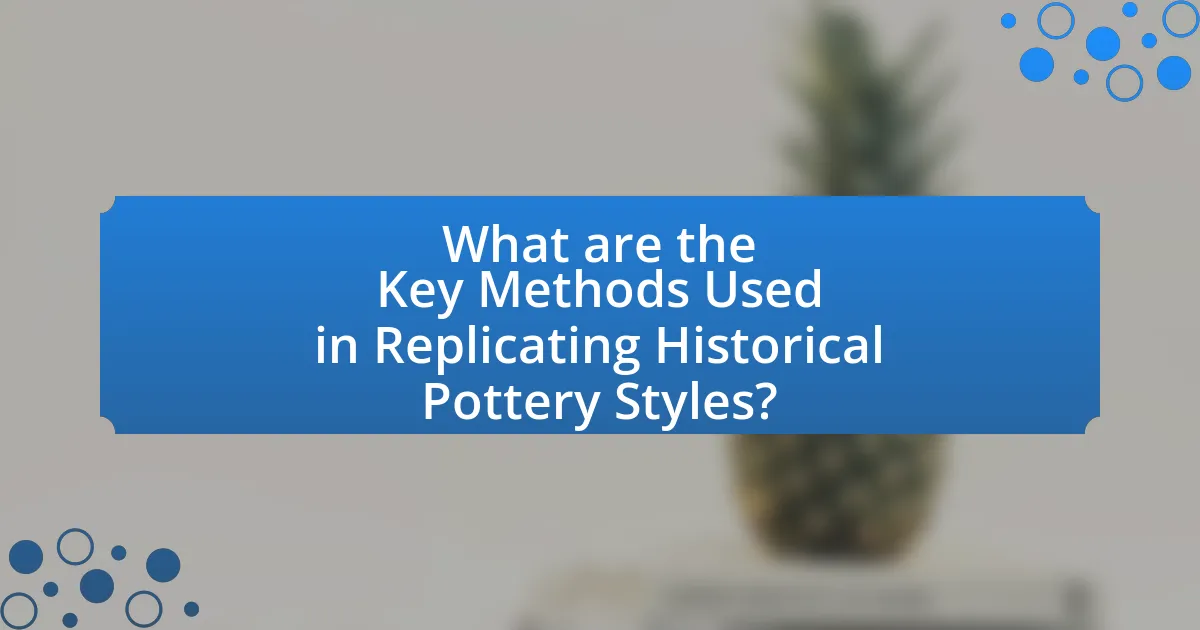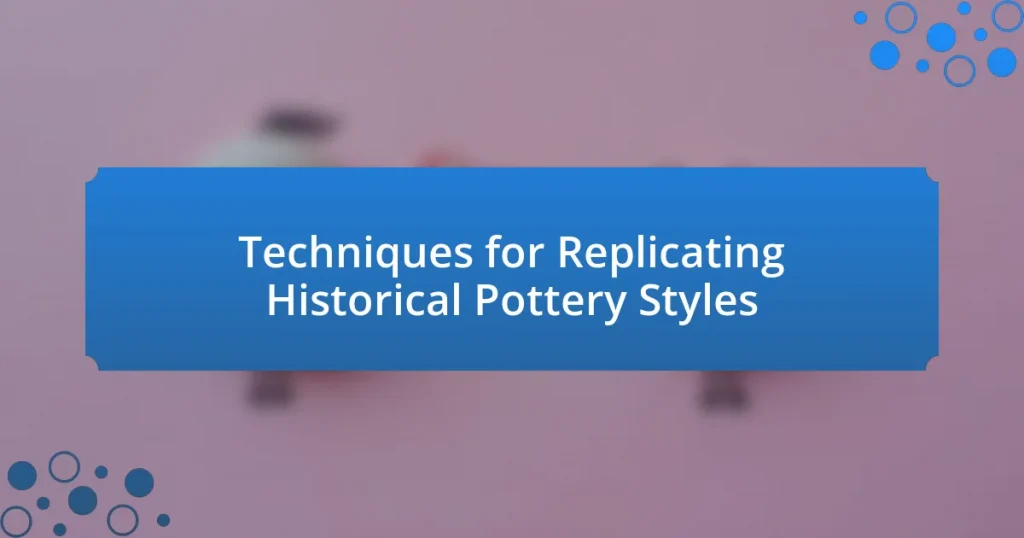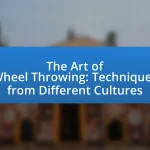The article focuses on techniques for replicating historical pottery styles, detailing methods such as slip casting, hand-building, and wheel throwing. It contrasts these traditional techniques with modern pottery practices, emphasizing the significance of materials and processes in achieving authenticity. The article also explores the cultural contexts that influence replication, the impact of traditional materials on the final product, and the importance of replication for preserving cultural heritage. Additionally, it addresses challenges faced in the replication process, common technical difficulties, and best practices for ensuring authenticity in pottery replication efforts.

What are the Techniques for Replicating Historical Pottery Styles?
Techniques for replicating historical pottery styles include slip casting, hand-building, and wheel throwing. Slip casting involves pouring liquid clay into a plaster mold, allowing for precise replication of intricate designs. Hand-building techniques, such as coiling and pinching, enable artisans to create unique forms while adhering to historical methods. Wheel throwing allows for the production of symmetrical pieces, reflecting traditional craftsmanship. Each technique can be supported by archaeological findings that demonstrate the methods used by ancient potters, such as the discovery of pottery shards that reveal specific forming techniques and materials used in different historical periods.
How do these techniques differ from modern pottery methods?
Historical pottery techniques differ from modern pottery methods primarily in their materials and processes. Traditional methods often utilize natural clay and hand-building techniques, such as coiling or pinching, while modern pottery frequently employs industrial materials and machinery, including electric wheels and commercial glazes. For instance, ancient potters relied on local clay sources and natural firing methods, such as open fires or kilns fueled by wood, which contrasts with contemporary practices that may use synthetic clays and gas or electric kilns for precise temperature control. This distinction highlights the evolution of pottery from artisanal craftsmanship to a more standardized industrial approach.
What historical contexts influence these replication techniques?
Historical contexts that influence replication techniques for pottery styles include the cultural significance of pottery in ancient societies, technological advancements in materials and methods, and the archaeological discoveries that inform modern practices. For instance, the use of specific clay types and firing techniques can be traced back to particular regions and time periods, such as the high-fired stoneware of East Asia developed during the Tang Dynasty, which reflects both the local resources and the trade networks of the time. Additionally, the revival of traditional pottery techniques in contemporary art movements often draws inspiration from historical practices, as seen in the work of artists who reference ancient Greek or Native American pottery styles, thereby preserving cultural heritage while adapting to modern aesthetics.
How do traditional materials impact the replication process?
Traditional materials significantly influence the replication process of historical pottery styles by affecting the authenticity and durability of the replicas. The use of clay types, glazes, and firing techniques that match the originals ensures that the replicated pottery not only resembles the historical pieces visually but also possesses similar physical properties. For instance, studies have shown that using local clay sources can replicate the specific mineral content found in ancient pottery, which impacts the final texture and strength of the pieces. Additionally, traditional firing methods, such as pit firing or wood firing, can replicate the unique surface finishes and color variations characteristic of historical pottery, thereby enhancing the overall fidelity of the replication.
Why is it important to replicate historical pottery styles?
Replicating historical pottery styles is important for preserving cultural heritage and understanding past societies. This practice allows artisans and researchers to study ancient techniques, materials, and aesthetics, which can reveal insights into the daily lives, trade practices, and artistic expressions of historical communities. For instance, the replication of ancient Greek pottery has provided valuable information about their social structures and rituals, as the designs often depict significant cultural narratives. Additionally, replicating these styles fosters a connection between contemporary society and its historical roots, ensuring that traditional craftsmanship is not lost over time.
What cultural significance do these pottery styles hold?
Pottery styles hold significant cultural importance as they reflect the historical, social, and artistic values of the communities that created them. These styles often embody the traditions, beliefs, and daily practices of a culture, serving as a medium for storytelling and identity. For instance, Native American pottery often features designs that are symbolic of nature and spirituality, illustrating the deep connection between the artisans and their environment. Additionally, archaeological studies have shown that pottery styles can indicate trade routes and interactions between different cultures, providing insights into historical relationships and exchanges.
How does replication contribute to historical preservation?
Replication contributes to historical preservation by allowing for the accurate reproduction of artifacts, which helps to maintain cultural heritage and provides educational opportunities. By creating replicas of historical pottery styles, researchers and artisans can study techniques, materials, and designs without risking damage to the original pieces. For instance, the replication of ancient pottery methods enables a deeper understanding of the cultural context and craftsmanship of the time, as seen in the work of institutions like the Smithsonian, which emphasizes the importance of preserving traditional techniques through replication. This practice not only safeguards the original artifacts but also ensures that knowledge and skills are passed down through generations, reinforcing the significance of cultural heritage.
What challenges are faced in replicating historical pottery styles?
Replicating historical pottery styles faces several challenges, primarily due to the loss of original materials and techniques. Historical pottery often utilized specific clay types and firing methods that are not readily available or replicable today. For instance, ancient Greek pottery was made from local clay that had unique mineral compositions, which can significantly affect the final product’s appearance and durability. Additionally, the firing temperatures and atmospheres used in historical kilns are difficult to reproduce, leading to variations in color and texture. Furthermore, the lack of comprehensive documentation on the exact processes used by ancient potters complicates efforts to achieve authentic replication. These factors collectively hinder the accurate reproduction of historical pottery styles.
What are the common technical difficulties encountered?
Common technical difficulties encountered in replicating historical pottery styles include achieving accurate clay composition, mastering traditional firing techniques, and replicating intricate decorative methods. Accurate clay composition is crucial, as variations in mineral content can affect the final product’s durability and appearance. Traditional firing techniques, such as wood-firing or pit-firing, require specific temperature control and atmosphere management, which can be challenging to replicate without specialized equipment. Additionally, intricate decorative methods, such as slip trailing or sgraffito, demand a high level of skill and precision, often leading to inconsistencies in the replication process. These challenges are documented in studies on pottery replication, highlighting the complexities involved in accurately reproducing historical artifacts.
How do artisans overcome these challenges?
Artisans overcome challenges in replicating historical pottery styles by employing a combination of traditional techniques and modern technology. They often study historical artifacts to understand the materials and methods used, allowing them to recreate authentic textures and forms. Additionally, artisans may utilize advanced tools such as 3D printing to prototype designs, which helps in refining their techniques before final production. Research indicates that hands-on workshops and collaborations with historians enhance their skills and knowledge, leading to more accurate reproductions. For instance, a study published in the Journal of Archaeological Science highlights how artisans who engage in experimental archaeology can effectively replicate ancient pottery styles by directly applying historical methods.

What are the Key Methods Used in Replicating Historical Pottery Styles?
The key methods used in replicating historical pottery styles include archaeological analysis, material sourcing, and traditional crafting techniques. Archaeological analysis involves studying existing artifacts to understand their composition, design, and manufacturing processes. Material sourcing ensures that replicators use similar clays and glazes that were historically available, which is crucial for authenticity. Traditional crafting techniques, such as hand-building and wheel-throwing, are employed to mimic the original methods used by artisans of the time. These methods are validated by historical records and scientific studies that detail the materials and techniques used in specific pottery styles, ensuring accurate replication.
How is the choice of clay significant in the replication process?
The choice of clay is significant in the replication process because it directly affects the authenticity and durability of the replicated pottery. Different types of clay possess unique properties, such as plasticity, firing temperature, and mineral composition, which influence the final appearance and structural integrity of the pottery. For instance, using earthenware clay can replicate the porous nature of ancient pottery, while stoneware clay can achieve a more durable finish. Historical studies, such as those by the American Ceramic Society, indicate that matching the original clay type is crucial for achieving accurate color and texture, thereby enhancing the fidelity of the replication to the historical style being emulated.
What types of clay are traditionally used in historical pottery?
Historically, earthenware, stoneware, and porcelain are the primary types of clay used in pottery. Earthenware, made from clay that is fired at low temperatures, is porous and often used for everyday items. Stoneware, fired at higher temperatures, is denser and more durable, making it suitable for functional and decorative pieces. Porcelain, known for its fine quality and translucence, is made from kaolin clay and fired at very high temperatures, resulting in a strong and non-porous material. These types of clay have been utilized across various cultures, with specific examples including the use of earthenware in ancient Mesopotamia and porcelain in Chinese dynasties, demonstrating their historical significance in pottery.
How does the clay’s composition affect the final product?
The composition of clay significantly influences the final product’s durability, texture, and appearance. Different minerals and organic materials in the clay, such as kaolinite, illite, and quartz, determine its plasticity, firing temperature, and color after firing. For instance, high kaolinite content results in a smoother texture and a white finish, ideal for porcelain, while a higher iron content can lead to reddish hues in stoneware. Additionally, the presence of additives like grog can enhance strength and reduce shrinkage during drying and firing, impacting the overall quality and functionality of the pottery.
What firing techniques are employed in historical pottery replication?
Historical pottery replication employs several firing techniques, including pit firing, wood firing, and salt glazing. Pit firing involves placing pottery in a pit filled with combustible materials, allowing for variable temperatures and unique surface effects. Wood firing utilizes a kiln fueled by wood, creating a natural ash glaze and distinctive color variations due to the interaction of flames and clay. Salt glazing involves introducing salt into the kiln during firing, which vaporizes and creates a glossy surface on the pottery. These techniques are validated by archaeological findings that show their use in various cultures, such as the ancient Greeks and Native American tribes, highlighting their significance in traditional pottery practices.
How do different firing temperatures influence the pottery’s characteristics?
Different firing temperatures significantly influence pottery’s characteristics, affecting its strength, porosity, color, and surface texture. Higher firing temperatures, typically above 1,200 degrees Celsius, lead to vitrification, where clay particles fuse, resulting in a denser, stronger, and less porous ceramic. This process enhances durability and water resistance, making the pottery suitable for functional use. Conversely, lower firing temperatures, around 900 to 1,000 degrees Celsius, produce more porous and fragile ceramics, often retaining more of the clay’s original texture and color variations. For example, earthenware, fired at lower temperatures, exhibits a more rustic appearance and is often used for decorative purposes. The specific temperature range and duration of firing also influence the final glaze effects, with higher temperatures often yielding more vibrant and glossy finishes due to the melting of glaze materials.
What traditional firing methods are still in use today?
Traditional firing methods still in use today include pit firing, wood firing, and salt glazing. Pit firing involves placing pottery in a pit with combustible materials, allowing for unique surface effects and colors. Wood firing utilizes a kiln fueled by wood, creating a natural ash glaze and varied textures, a method that dates back centuries. Salt glazing involves introducing salt into the kiln during firing, resulting in a distinctive glossy surface. These methods are employed by contemporary potters to replicate historical pottery styles, preserving ancient techniques while producing modern works.
What decorative techniques are essential for historical pottery styles?
Essential decorative techniques for historical pottery styles include slip trailing, sgraffito, and underglaze painting. Slip trailing involves applying liquid clay to create raised designs, commonly seen in medieval pottery. Sgraffito is a technique where a layer of slip is scratched away to reveal the clay body beneath, prevalent in Italian Renaissance ceramics. Underglaze painting allows for intricate designs to be painted on the pottery before glazing, a method used in Chinese porcelain. These techniques are validated by their historical usage in various cultures, demonstrating their significance in the evolution of pottery decoration.
How do glazing methods vary across different historical periods?
Glazing methods have varied significantly across historical periods, reflecting advancements in technology, cultural influences, and aesthetic preferences. In ancient times, such as during the Egyptian and Mesopotamian eras, glazing techniques primarily involved the use of natural minerals and simple firing methods, resulting in basic, often opaque glazes. The introduction of lead glazes in the Roman period marked a shift towards more vibrant colors and a glossy finish, enhancing the decorative potential of pottery.
During the Middle Ages, the development of tin glazes in Europe allowed for the creation of white, opaque surfaces that could be painted upon, leading to the distinctive majolica style. The Renaissance saw further innovation with the introduction of salt glazing, which produced a unique texture and sheen, particularly in German stoneware.
In the 18th and 19th centuries, the Industrial Revolution brought about mass production techniques and the use of new materials, such as bone ash in porcelain glazes, resulting in finer, more durable products. Each of these periods showcases a progression in glazing methods, influenced by technological advancements and cultural exchanges, ultimately shaping the evolution of pottery styles throughout history.
What role do surface treatments play in the replication process?
Surface treatments are crucial in the replication process as they enhance the aesthetic and functional qualities of replicated pottery. These treatments, which can include glazing, polishing, or applying slips, mimic the original finishes found on historical pottery, thereby ensuring authenticity in appearance and texture. For instance, specific surface treatments can replicate the sheen and color variations that characterize traditional pottery styles, making the replicas visually indistinguishable from the originals. Additionally, surface treatments can improve durability and resistance to wear, which is essential for maintaining the integrity of the replicated pieces over time.

How can one effectively learn and apply these techniques?
To effectively learn and apply techniques for replicating historical pottery styles, one should engage in hands-on practice combined with thorough research. Engaging in hands-on practice allows individuals to directly experience the materials and methods used in historical pottery, while research provides context and understanding of the cultural significance and technical details behind each style. For instance, studying archaeological findings and historical texts can reveal specific techniques, such as coiling or slip decoration, used by ancient potters. Additionally, workshops led by experienced artisans can offer practical guidance and immediate feedback, enhancing the learning process. This dual approach of practice and research ensures a comprehensive understanding and skillful application of historical pottery techniques.
What resources are available for learning historical pottery replication?
Resources for learning historical pottery replication include books, online courses, workshops, and academic journals. Notable books such as “The Pottery of Ancient Egypt” by James F. Romano provide in-depth insights into techniques and styles. Online platforms like Coursera and Udemy offer courses focused on pottery techniques, including historical replication. Workshops conducted by pottery studios or museums often provide hands-on experience with traditional methods. Academic journals, such as the “Journal of Archaeological Science,” publish research on historical pottery techniques, offering valuable information for learners.
Which books or online courses are recommended for beginners?
For beginners interested in techniques for replicating historical pottery styles, “The Pottery Handbook” by Andrew Holdsworth is highly recommended, as it provides foundational knowledge and practical techniques. Additionally, the online course “Introduction to Pottery” offered by Skillshare covers essential skills and historical context, making it suitable for novices. These resources are validated by their popularity among pottery enthusiasts and educators, ensuring they effectively support beginners in mastering the craft.
How can workshops enhance practical skills in pottery replication?
Workshops enhance practical skills in pottery replication by providing hands-on experience and expert guidance. Participants engage directly with materials and techniques, allowing them to practice and refine their skills in a structured environment. Research indicates that experiential learning, such as that found in workshops, significantly improves skill acquisition and retention, as evidenced by studies showing that learners retain 75% of what they practice compared to only 5% from lectures. Additionally, workshops often include demonstrations of historical techniques, enabling participants to observe and replicate methods used by artisans in the past, thus deepening their understanding of pottery styles.
What best practices should be followed when replicating historical pottery styles?
To effectively replicate historical pottery styles, artisans should prioritize thorough research on the specific cultural and historical context of the pottery being replicated. This includes studying original artifacts, examining their materials, techniques, and decorative methods. For instance, understanding the clay composition and firing techniques used in ancient Greek pottery can significantly influence the authenticity of the replication. Additionally, utilizing traditional tools and methods, such as hand-building or wheel-throwing, ensures that the replication process remains true to historical practices. Documented evidence, such as archaeological findings and scholarly articles, supports these practices by providing insights into the craftsmanship of the time. Following these best practices enhances the accuracy and authenticity of replicated pottery styles.
How can one ensure authenticity in their replication efforts?
To ensure authenticity in replication efforts of historical pottery styles, one must conduct thorough research on the original artifacts, including their materials, techniques, and cultural context. This involves analyzing existing literature, consulting with experts in archaeology and pottery, and studying the physical characteristics of the original pieces. For instance, using historically accurate clay types and glazes, as well as traditional firing methods, can significantly enhance the authenticity of the replication. Additionally, employing techniques such as slip decoration or hand-building methods that were prevalent during the original period can further ensure that the replication closely resembles the historical style.
What common mistakes should be avoided during the process?
Common mistakes to avoid during the process of replicating historical pottery styles include neglecting thorough research on the original techniques, using inappropriate materials, and failing to accurately replicate firing conditions. Neglecting research can lead to misunderstandings of the historical context and methods, which are crucial for authenticity. Using inappropriate materials can compromise the integrity and appearance of the replicated pottery, as historical styles often rely on specific clay types and glazes. Additionally, failing to replicate firing conditions, such as temperature and atmosphere, can result in significant differences in the final product compared to the original pieces. These mistakes can undermine the goal of achieving an accurate and respectful replication of historical pottery styles.


